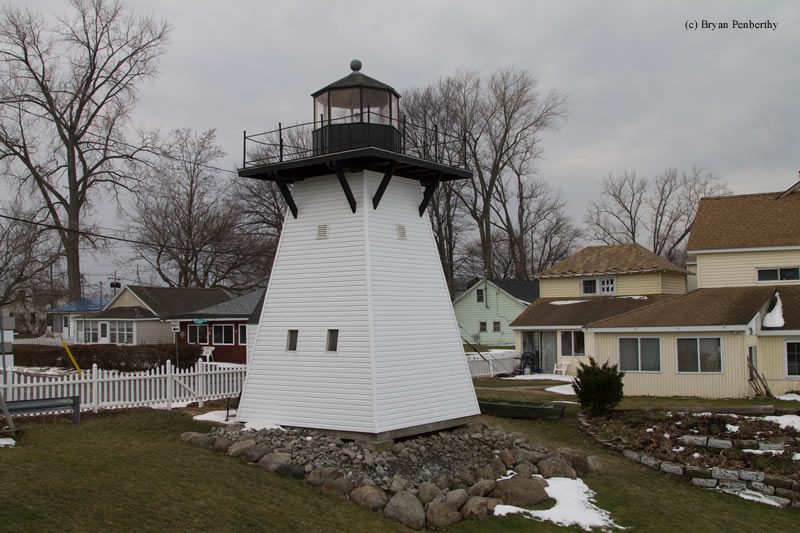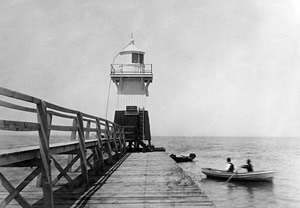Olcott Harbor (Replica) Lighthouse
Olcott, New York - 2003 (1873**)

History of the Olcott Harbor (Replica) Lighthouse
Posted/Updated by Bryan Penberthy on 2015-01-25.
Harbors of refuge along the southern shore of Lake Ontario were few and far between in the early 1830s. Prior to the erection of the Olcott Lighthouse, there were few, if any lighthouses, between the mouths of the Niagara and Genesee Rivers, a span of nearly 85 miles.
As there weren't many lighthouses within that span, the Lighthouse Board had plans to erect several within a short time frame. One of the first lighthouses erected between the two points was the Oak Orchard Lighthouse in Point Breeze, NY. Erected in 1871, it was a fourth-order lighthouse to mark the harbor.
The next lighthouse to be erected was this lighthouse that you are reading about now, the Olcott Lighthouse. Erected in 1873 at the mouth of 18-Mile Creek and Lake Ontario, and although it was originally listed as being a fourth-order lighthouse, when completed, it was outfitted with a smaller sixth-order lens.
In 1875, the Lighthouse Board erected the Thirty Mile Point Lighthouse in Somerset. Equipped with a third-order Fresnel lens, this lighthouse was meant to be a major coastal lighthouse, capable of guiding vessels well offshore heading towards Rochester or to the Welland Canal.
The story of the Olcott Lighthouse starts here:
By 1867, Major Tardy, Army Corps of Engineers, had developed a plan to improve the harbor at Olcott, where Eighteen Mile Creek empties into Lake Ontario. His design called for two parallel piers, about 200 feet apart, extending out to a depth of 11 feet. To pay for the work, Congress had appropriated $60,000 on March 2, 1867.
Construction of the piers had started that year and by 1873, they were out to a depth of 9 feet. At that point, a 50-foot wide channel was dredged to a depth of 10 feet. The Lighthouse Board had announced that a fourth-order light would be established during the summer / fall of that year.
However, the Annual Report of the Lighthouse Board for the year 1874, painted a different picture:
Olcott, Lake Ontario, New York - A frame-beacon, with a focal plane of 32 feet above the lake-level, was established on the end of west pier; a fixed white light, sixth order, was shown on and after November 1, 1873.
Erected at the end of the west pier was a 27-foot tall square pyramidal tower. The lower half was painted brown, the upper half painted white. It displayed a fixed white light using a sixth-order lens to achieve a visibility of 11½ miles.
In 1880, a few repairs were made and the beacon was repainted. That year, to replace an inefficient lens, a new one was ordered, which was installed by the following year. By 1890, the elevated walk along the pier to the lighthouse was in poor condition. To remedy this, a contract was signed on June 16, 1891 to rebuild the entire walkway, which was completed by the following year.
From 1867 through 1890, Congress appropriated a total of $163,000 for improvements to the Olcott Harbor despite a low number of vessels and tonnage entering. In 1881, a mere 36 ships entered with a total of 3,075 tons.
 Olcott Lighthouse (National Archives)
Olcott Lighthouse (National Archives)
Despite the low utilization, the federal government continued to maintain the harbor. In 1902, Congress appropriated $15,000 for harbor improvements. That same year, a new foundation of four concrete piers was built from the water level to the beacon sills. The beacon was then anchored to bolts embedded into the concrete.
By the end of the 19th century, the Town of Olcott was experiencing rapid growth as a resort town. Many functions held in town were well attended, including the Pioneer Association Picnic in 1899. The picnic had nearly 20,000 guests, including Governor Theodore Roosevelt.
By the turn of the century, tourists were arriving by rail and steamboat service, some from as far away as Toronto. The International Railway Company extended a line from Lockport to Olcott in 1902, where they built an amusement park and the Olcott Beach Hotel.
The Olcott Beach Hotel was the largest of the eight hotels in town. It featured 100 rooms, including a 14,000 square foot ballroom, expansive dining room overlooking the lake, a beauty parlor, barber shop, game room, changing rooms, pier, amusement park and its own beach.
During the 1880s, the Lighthouse Board began switching the illuminant over from whale oil to the more efficient kerosene, commonly called mineral oil. It burned cleaner and brighter, but the downside was its volatility, and as such, it was not recommended to store it in the tower or keeper's dwelling.
To rectify that, in 1906, the Olcott Lighthouse received an iron oil house. The Annual Report of the Lighthouse Board had the following entry:
71. Olcott, entrance to Olcott Harbor, Lake Ontario, New York - An iron oilhouse of 540 gallons capacity was built on a concrete foundation. Steps were built at the outer end of the elevated walk on the pier.
A Notice to Mariners went out in local papers stating that on June 29, 1921, the characteristic of the Olcott Lighthouse was changed to "flashing white of 230 candlepower with two flashes every six seconds." At that time, the light was changed over to acetylene.
Two things led to the downfall of the tourist mecca that was Olcott, the onset of the Great Depression, which dried up a lot of disposable income, and the automobile. Prior to mass adoption of the car, people had to take the train, horse and buggy, or a steamer to arrive in town.
Because travel was slower back in the day, people stayed for several days when they arrived, thus requiring a hotel. With the automobile, many could make the trip to Olcott, spend the day, and make it home, all in the same day.
On November 1929, the wooden lighthouse was discontinued in favor of an electric light mounted atop a 25-foot-tall steel I-beam. The electric current was carried to the light through a submarine cable.
By 1930, the timber piers were in poor condition. Many areas had deteriorated and several sections had been washed away. Concerned citizens, which included the Olcott Yacht Club, formed the Olcott Community Association with a mission to save the piers and ultimately, the harbor.
The American Construction Company of Cleveland, Ohio was selected as the contractor to rebuild the piers. Commodore W.F. Faber Gooding of the Olcott Yacht Club negotiated to save the lighthouse, which was moved to the club's property.
At that time, the 15-ton lighthouse minus the lantern was moved 800 feet to the property of the Olcott Yacht Club, which was near the entrance of the pier. The group used the lighthouse as a judges' stand during regattas, a storehouse, and a community landmark.
By the late 1930s, most of the tourism industry in Olcott was dead. The once great Olcott Beach Hotel, due to a crumbling foundation, was demolished in 1937. Other businesses closed up shop.
By 1963, the lighthouse was in poor condition. As the yacht club members felt the structure could not be saved, it was torn down. In the early 2000s, just over a dozen people formed the Olcott Lighthouse Society with the mission to create an exact replica of the Olcott Lighthouse.
Through private donations, $6,000 was taken in. Without original blueprints or plans, the group, armed with old photographs developed a construction plan. The Olcott Lighthouse Society built the 27-foot tall replica lighthouse in the spring of 2003.
Although tourism in Olcott hasn't fully recovered to the state it was in the early 1900s, it is starting to make a comeback. Nearly 100 years later, in 1999, a small committee was formed with the hope of returning an amusement park to the town, which once had several.
While searching for pictures of the former Olcott Amusement Park, they came across Jack Campbell from Culver, Indiana that although he didn't have pictures of the carousel, he did own several of the original kiddy rides from the Rialto Amusement Park in Olcott.
Although the group had wanted the rides, they were really looking for a carousel. It just so happened that Mr. Campbell also had a 1928 Herschell-Spillman carousel as well. After negotiations and several years of hard work, the group opened the newly restored roundhouse and carousel on May 17, 2003.
Over the next few years, the group built several new pavilions and began to add the kiddie rides. In 2007, a kiddy Ferris wheel that once operated at the former Whistle Pig in Niagara Falls was restored and opened in the park. The best part about the Olcott Beach Carousel Park is that each of the rides cost only 25¢.
While in the Olcott-Newfane, spend some time to visit the Lakeview Village Shoppes, blow off some steam at Krull Park, get some food at Gordie Harper's Bazaar, and get some popcorn at Bye's Popcorn, which was established in the town in 1923.
Reference:
- Annual Report of the Light House Board, U.S. Lighthouse Service, Various years.
- Various Government Documents, Federal & State Governments, Various dates.
- Great Lakes Lighthouses Encyclopedia, Larry & Patricia Wright, 2011.
- "Old lighthouse, an Olcott landmark, to leave service," Staff, Lockport Union-Sun and Journal, May 23, 1930.
- "Olcott Light Rebuilt," Bill Edwards, Lighthouse Digest, April 2004.
- "Olcott Light: Gone and Nearly Forgotten," Staff, Lighthouse Digest, April 2000.
- "Piers At Olcott Are Now Entirely Reconstructed," Staff, Lockport Union-Sun and Journal, July 11, 1930.
Directions: The lighthouse sits at the corner of Lockport Street (Route 78) and Ontario Street in the Town of Olcott.
Access: The lighthouse is owned by the Town of Olcott. Grounds open. Tower open in season.
View more Olcott Harbor (Replica) Lighthouse picturesTower Height: Unknown
Focal Plane: Unknown
Active Aid to Navigation: Deactivated (1930)
*Latitude: 43.33900 N
*Longitude: -78.71500 W
See this lighthouse on Google Maps.
